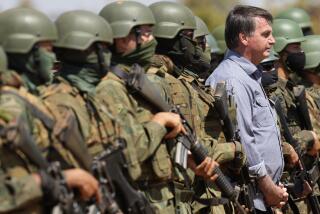BOOK REVIEW : ‘Interesting Tidbits’ About Military Might : DIRTY LITTLE SECRETS; Military Information You’re Not Supposed to Know About <i> by James F. Dunnigan and Albert A. Nofi</i> William Morrow $19.95, 384 pages
- Share via
Let me say right away that the title of “Dirty Little Secrets” is pure hype. The authors readily admit that none of the short entries in this collection of odds and ends about the art of war in the 1990s are genuine military secrets, and precious few of them struck me as “dirty”--whatever that’s supposed to mean. The book should have been called “Interesting Little Tidbits.”
Still, “Dirty Little Secrets” is full of surprises about the inner workings of war-making machinery around the world. And, with war and rumors of war no more distant than the front page of today’s newspaper, “Dirty Little Secrets” is a useful briefing on what is really at stake if the sitzkrieg in the Persian Gulf turns into a shooting war.
The authors have lumped their data under seven sweeping headings (“Ground Forces,” “Air Forces,” “High Tech”) and nearly 900 entries, but it’s mostly a random assortment. And that’s why, by the way, “Dirty Little Secrets” is an ideal fixture in certain rooms of the house.
Some of the information falls into the “gee whiz” category. The military specifications for chewing gum are 13 pages long. The standard U.S. Army boot is designed to last eight years in peacetime use, but only six months in combat. A B-2 “Stealth” bomber prices out at $137.50 per ounce. Sweden’s navy operates the world’s only laundry ship. Thanks to some “May-December” weddings at the turn of the century, the United States is still paying pensions to a dozen widows of Civil War veterans.
A good deal of attention is paid to military exotica. We learn, for instance, about “reactive armor”--blocks of explosives on the outside of tanks that explode outward to destroy incoming artillery shells--and use of robotics, electronics and NBC (Nuclear-Biological-Chemical) weapons on the battlefields of the 21st Century.
Other entries are really short essays on military tactics, technology and terminology: troop deployment, the use of artillery, and the precise definition of such terms as Lock and Load, Main Battle Tank and even Rock and Roll.
But there are some pointed lessons here. I was faintly reassured by the distinctions that the authors make between “real” armies and ceremonial, political, police and commercial armies. And there’s a certain grim fascination in their extended discourse on the design and function of the humble bullet as the ultimate instrument of death in battle.
But what I found most striking (and, in many instances, most surprising) in “Dirty Little Secrets” were its quiet revelations of what really counts in battle. The authors make the point, again and again, that high technology at high cost is not necessarily what will win a war:
* The U.S. Army pays $4 million for each of its M-1 “Abrams” tanks, but some future tank battles may be decided by the use of inflatable decoy tanks that cost $3,300, weigh only 50 pounds, fit into a duffel bag and paint an infrared “signature” that is indistinguishable from a real tank.
* The rag-tag army of Chad managed to beat well-equipped Libyan forces, armed with Soviet tanks and other armored vehicles, by mounting anti-tank weapons on Toyota mini-trucks.
* The Swiss army maintains a reserve of 20,000 carrier pigeons, which are certainly cheaper than a high-tech communications system and may be more “survivable” in wartime.
* After a Russian soldier froze to death on maneuvers, a war-hardened marshal summoned every division commander in the Soviet army to Moscow for a lecture on the use of the old-fashioned greatcoat for survival in winter. “Have Russian soldiers forgotten how to sleep in their overcoats?” he thundered.
Only a year ago, we were enthralled by the advent of peace and freedom in Europe. Back then, “Dirty Little Secrets” would have appeared to be a quaint joke. (In fact, the authors still refer to Central Europe as “the most likely area of use” for many weapons and tactics.)
Today, we live in dread of war in the Persian Gulf, and--tragically but truly--”Dirty Little Secrets” is a handbook for our times.
Next: Richard Eder reviews “Gentleman Rebel: The Memoirs of H. Stuart Hughes” (Ticknor & Fields).
More to Read
Sign up for our Book Club newsletter
Get the latest news, events and more from the Los Angeles Times Book Club, and help us get L.A. reading and talking.
You may occasionally receive promotional content from the Los Angeles Times.






